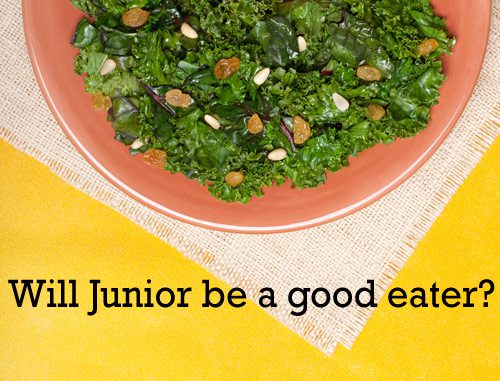The answer is yes, especially if you’re aware of how your pregnancy diet affects baby’s future tastes. Here’s what you can do
By Kate Geagan, M.S., R.D.
“Mommy, more please.”
Those magic words play like music to a mother’s ears, especially if the dish in question is something that qualifies as “healthy.” And although this scenario might seem far off while you’re still stuck in what could be The World’s Largest Pants, it appears that a budding eater’s “food road map” actually begins to develop while she’s still floating in that bag of waters.
That’s right—a growing body of evidence suggests your own personal cuisine routine influences your baby long before his first actual taste of solid food. All sorts of flavors from your diet are transmitted through amniotic fluid, and later via breast milk, to your little one, helping shape the trajectory of his palate even before he’s actually eaten any foods for himself. A study in Pediatrics, for example, found that infants whose mothers drank carrot juice during pregnancy or nursing reacted more positively to carrots than those whose mothers had abstained. Other studies from around the world have found similar results: In France, babies of mothers who consumed anise-flavored beverages more readily accepted the taste than babies of mothers who skipped such drinks, and research in Ireland found similar results with garlic.
| The “O” factor If there’s one time when the extra investment for pesticide-free foods counts, it’s now: A new report from The Organic Center reviewed more than 30 studies and concluded that an organic diet before and during pregnancy can help the fetus develop a healthy endocrine system—which can mean an easier time managing weight and blood sugar and less chance of obesity and diabetes later in life. |
Far from a reason to panic—“Oh great, one more thing I’m not doing right!”—consider these findings as yet another testament to the deep power of your own diet during this critical time. It’s OK if you don’t love every single veggie under the sun, but do stretch yourself. Try to shop different parts of the produce section each week. Or stick with what’s in season, a natural way to migrate through different foods and flavors. Serving a variety of colors is another easy way to sneak in more options; make sure there are always three or more hues on your plate.
Above all, savor this time when you actually have control over every food choice that hits your baby’s palate, and start stacking the odds for when she finally reaches the dinner table herself. Another plus: In the process, you’ll add even more key nutrients to your own diet, and maybe the good stuff will become habit for you, too. For a simple and nutritious side dish of flavorful, healthful greens, try this recipe.
Gorgeous greens
Loaded with calcium, vitamin K, and lutein, greens like kale and chard are nutrient powerhouses: You get 5 grams of fiber and 4 grams of protein in ¾ cup of this stuff. If you’re new to greens, make life easier by buying the pre-trimmed ones carried by many supermarkets. They cook fastest when you remove the stems before chopping—just run a knife along both sides of each stem and pull it out.
- 2 tablespoons olive oil
- ½ pound each kale, collard greens, and Swiss chard; rinsed, stems removed, and leaves chopped
- 1 clove garlic, minced
- Handful of pine nuts or chopped walnuts and ¼ cup golden raisins (optional)
- Balsamic vinegar
- Salt and pepper
Place oil in a large skillet over medium heat. When hot, add chopped greens (it’s OK if they’re still a bit damp from rinsing). Cook, stirring frequently, until greens are almost wilted, about 3 minutes. Add garlic (and nuts and raisins, if using) and stir 1 minute more. Add a splash of balsamic vinegar and remove from heat. Add salt and pepper to taste; toss to mix before serving. Serves 4.
Kate Geagan, M.S., R.D., is an award-winning dietician in Park City, UT, and author of Go Green, Get Lean: Trim Your Waistline with the Ultimate Low Carbon Footprint Diet. She’s the mother of two toddlers.
